How To Change A Taped Tubular Tire
This commodity volition discuss the mounting and gluing of tubular tires. The tubular tire is made from a tire casing that is then sewn effectually an inner tube. The stitching is covered with a strip of cloth called "base tape". The tubular is then glued to a special rim, called a tubular rim. The tubular organization is not interchangeable with the common "clincher" organisation.
1
Getting Started
What Tools do I demand?
- Truing stand to concur cycle. Utilise rags to protect stand up from glue drips
- Acid brush or other clean narrow brushes, such equally erstwhile molar castor
- Acetone or other potent solvent
- Flooring pump
- Knife or scraper

NOTE: The tubular tire system, even when mounted properly, is however susceptible to failure during employ. Every precaution should exist taken when bonding the tubular to the rim. At this time there are no manufacture standards for tubular mounting.
The basic principles that apply to gluing and adhesive bonding utilise to tubular mounting. More often than not, there should exist enough adhesive to bond the tire and rim only not excessive amounts of mucilage. Excessive amounts of gum tin become especially susceptible to failure from heat. There will be limits on the strength the bail between rim and tire.
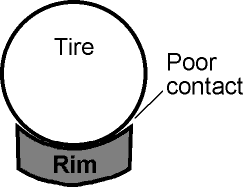
- The tubular tire shape may not be a good match with the radius of a item tubular rim. The tubular bond forcefulness comes from the outer edges of the rim more than the heart. If the tire is also small for the rim, there will not be expert contact at the outer edges. In the cross section paradigm below, there will be poor contact between tire and rim at the outer edges.
- Contact cements tend to soften and loose strength when they are heated. Hard braking during a descent can cause enough rim heat build up to soften tubular mucilage.
- Wet weather condition tend to weaken the bond. Never gum a tubular out in rain or when the base surfaces are wet. Use care when washing tubular and avoid scrubbing the rim/tire interface.
- The tire is held on to the rim by gum, tension from the cord, and by air pressure. If a tire flats, the grip to the rim is weakened, and the tire is susceptible to coming off the rim.
- During use, the bicycle and tire are subjected to several unlike types of stresses. The worst stress for the tubular system is a lateral load or lateral impact. Striking bumps during a corner, where the bicycle comes of the ground and so lands with an impact tends to push button the tire sideways. This may cause the tire to come off the rim, either partially or entirely, which may consequence in a crash of the rider.
Most bicycle tubular glues are variations on contact cements. Tubular cement must hold the tire to the rim, but yet be somewhat flexible and giving when the tire is impacted laterally. Expoy or hard gum would tend to shatter when impacted rather than yield during a daze. Tubular cements tend to utilize volatile solvents that must bleed or dry out earlier the bail is fully secure. While the application technique is critical to maximum bonding strength, glue brands will vary in quality and agglutinative strength. For more detail on tubular bonding see the technical article by Dr. Colin Howat on the subject area of Tubular Tire Adhesive Functioning at the Kurata Thermodynamics Laboratory.
The safety of the passenger depends on the best possible gluing procedures. A clean piece of work expanse is important, as is time and patience. Ideally, it would be best to have three days to bond a tubular to the rim. This would allow for total drying of base coats. It is possible to glue a tire in a shorter amount of time, merely information technology is important to understand that tubular adhesive require time for proper curing. The bond force increases afterwards the tire is initially mounted.
ii
Gluing Procedure—New or Bare Rim
As with all bonding procedures, clean surfaces are important. Use a clean rag and a solvent that will not get out an oily film, such as acetone or alcohol, to clean the rim surface. An oily surface volition tend to repel the adhesive. Permit rim to dry completely before continuing. Wipe with a clean cloth just. Always take precautions when using potent solvents such as acetone. Use protective gloves.
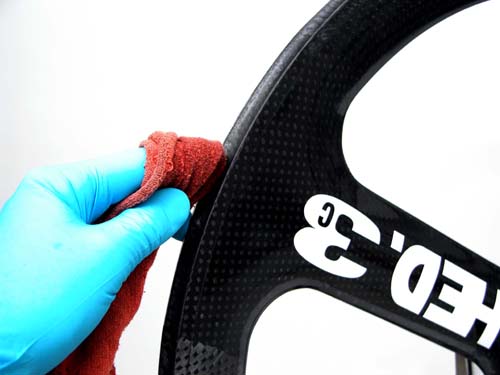
Carbon gluing surfaces accept special considerations. Virtually manufacturers of carbon rims state that acetone is acceptable for cleaning the gluing surface. Contact manufacturer for their recommendations. Abrading the carbon can be useful for cleaning surface. This is especially true if there is "mold release" on the rim. This is a slick substance that allows the carbon to come up out of the mold during manufacturing. Utilise only a medium grade sand newspaper or emory cloth (approximately 120 grit). Exercise not abrade down to the fibers themselves. Clean with an oil-free solvent after whatever sanding.
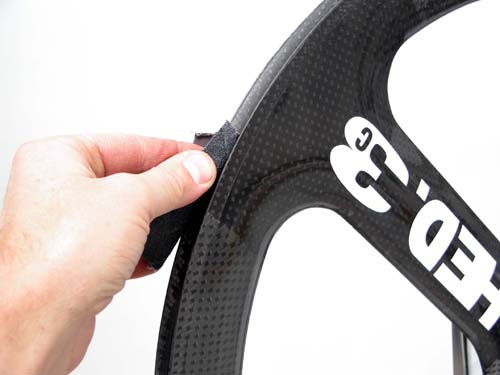
The tubular tire tin can be a tight fit to the rim. It can help to stretch the tire on a dry rim and inflate it to full pressure. Allow bicycle to sit overnight. If time is an consequence, the tire tin can be manually stretched by placing it over your back "bandoleer" fashion. Place a knee in the tire and stretch, using your back.
Audit base tape. If the base tape is covered with latex, try to scrape clean with a sharp edge. If scraping does not announced to remove any glue, do non scrape further. If scraping appears to make clean and articulate the tape, keep until full width of record is finished.
Ideally, a bonded articulation should accept a little gum equally possible but without "starving" the joint. It typically takes quite a bit of mucilage, however, to become a full bail with many tubulars. If yous are using the typical tube of gum, you can wait to use one tube per new bike fix. If the rim has a adept base coat already, you will need less glue.
Apply a single coat of gum to the base of operations tape. Inflate tubular until base record rolls outward. Handle the tire by the sidewalls. Pinch tire in the center to class a "figure 8". Apply a dewdrop of glue a few centimeters at a fourth dimension. Apply an acid brush or tooth brush to spread the adhesive evenly across the base of operations tape. Continue applying small-scale sections of glue at a time until entire base tape is coated, including the area at valve.
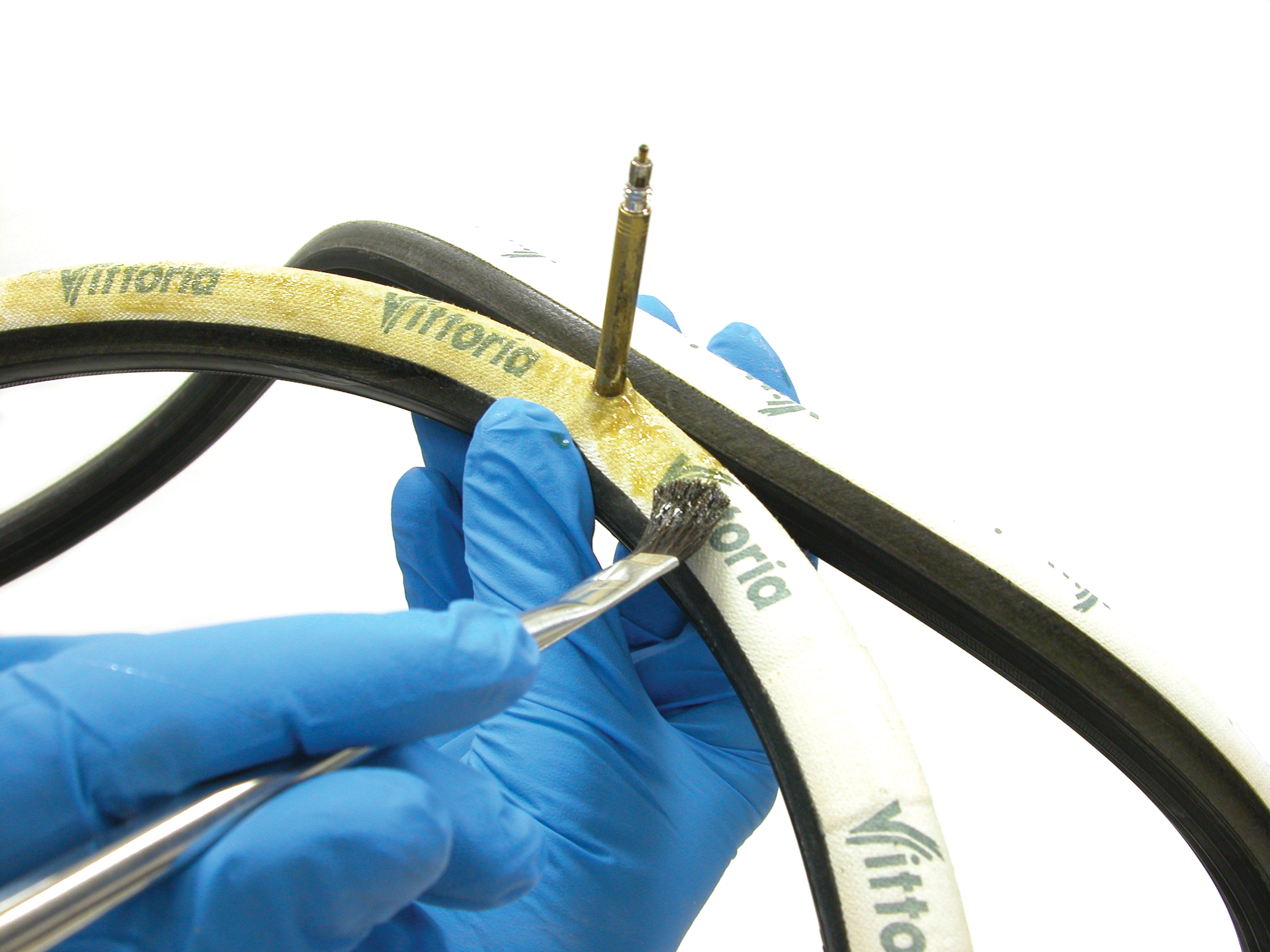
Employ care not to get gum on sidewall of tire. Notwithstanding, if gum does get on sidewall, practise not remove with solvent. Simply allow drying and go out information technology lonely. Hang tire off ground in a grit free surround allow to dry out completely. A dry tire volition be easier to handle when mounted to the rim.
It can be useful to hold the bicycle in a truing stand. Identify rags to protect the stand up from gum. Ready the calipers to elevate slightly on the rim braking surface. This will keep the rim from rotating while gum is applied to the summit.
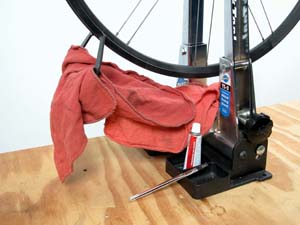
If rim has no base coat, apply a first coat. Utilize an agglutinative bead a brusque department of rim. Spread evenly the full width of the rim with a clean castor. Allow this commencement glaze to completely dry, ideally overnight. Apply an additional coat and allow this coat to dry also. The tertiary and peradventure final glaze volition be used to mount the tire while it is tacky, and not completely dry. If at that place is a poor fit between tire shape and rim shape, more coats may exist required.
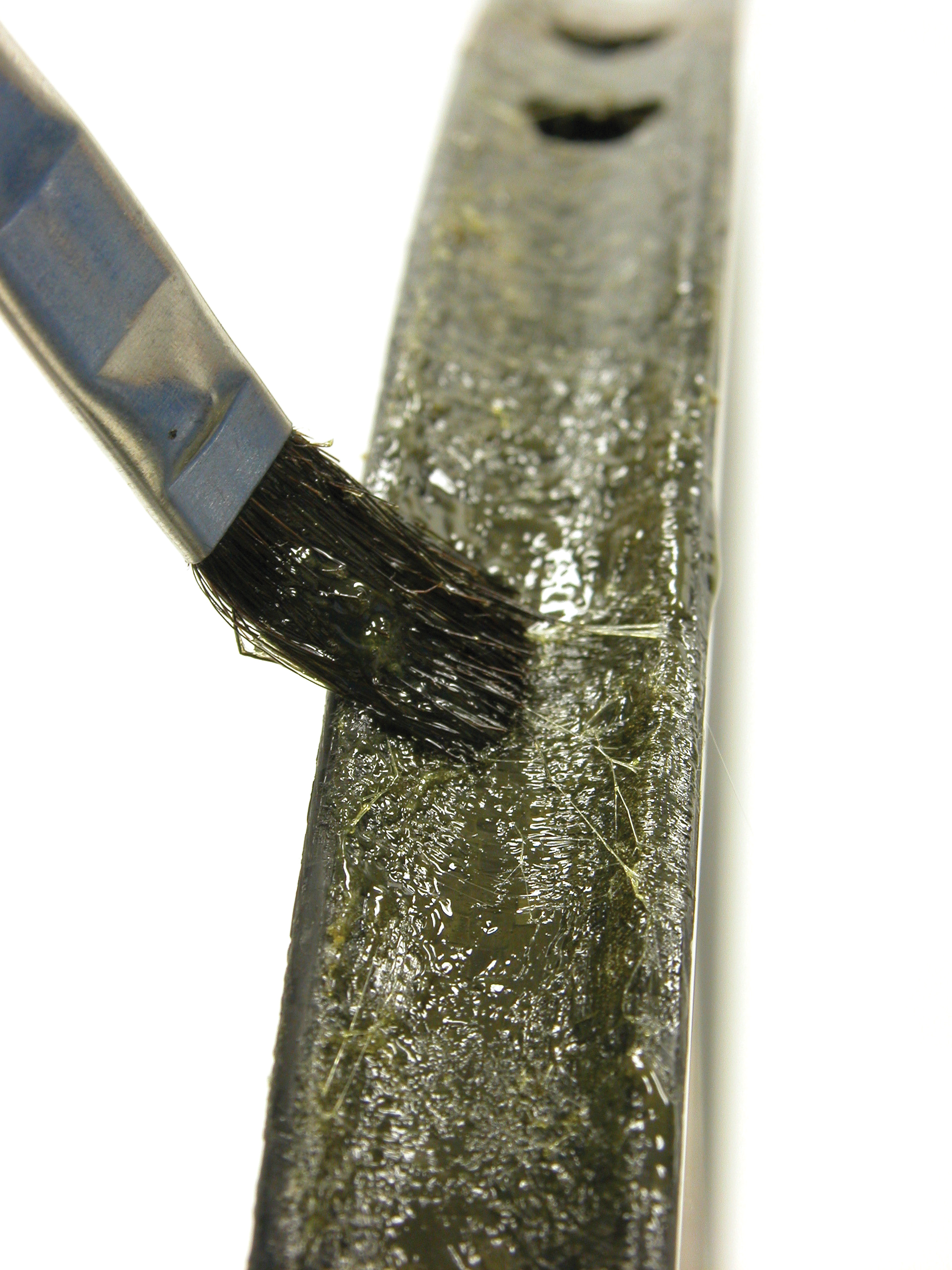
It is important the adhesive be applied fully to the edges of the rim. Most of the holding power will come up from the outer edges of the tubular rim. Test edges for glue, equally seen in the prototype beneath:
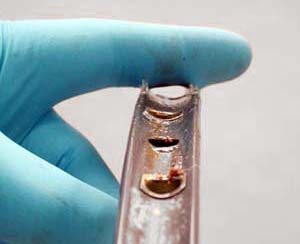
Subsequently applying the final coat the rim, allow to only partially dry. This may have 60 seconds to a few minutes, depending upon the mucilage and atmospheric conditions. Deflate the tubular until it is soft, but leave enough air so the tire holds its shape. This will help keep the sidewalls clean during mounting. Find a clean flooring area to work on, such as tile, or even a toolbox lid. Do non mount on carpet, grass, or any surface that may contaminate the rim. Place the wheel vertically and identify the valve in the valve pigsty. Begin to pull outward on the tire, belongings the tire approximately 12-inches (30cm) to either side of the valve. Work the tire on a section at a time, while continuing to maintain pressure on the tire. The last section may be particularly tight and difficult to become on the rim. Use thumb pressure to strength tire onto rim.
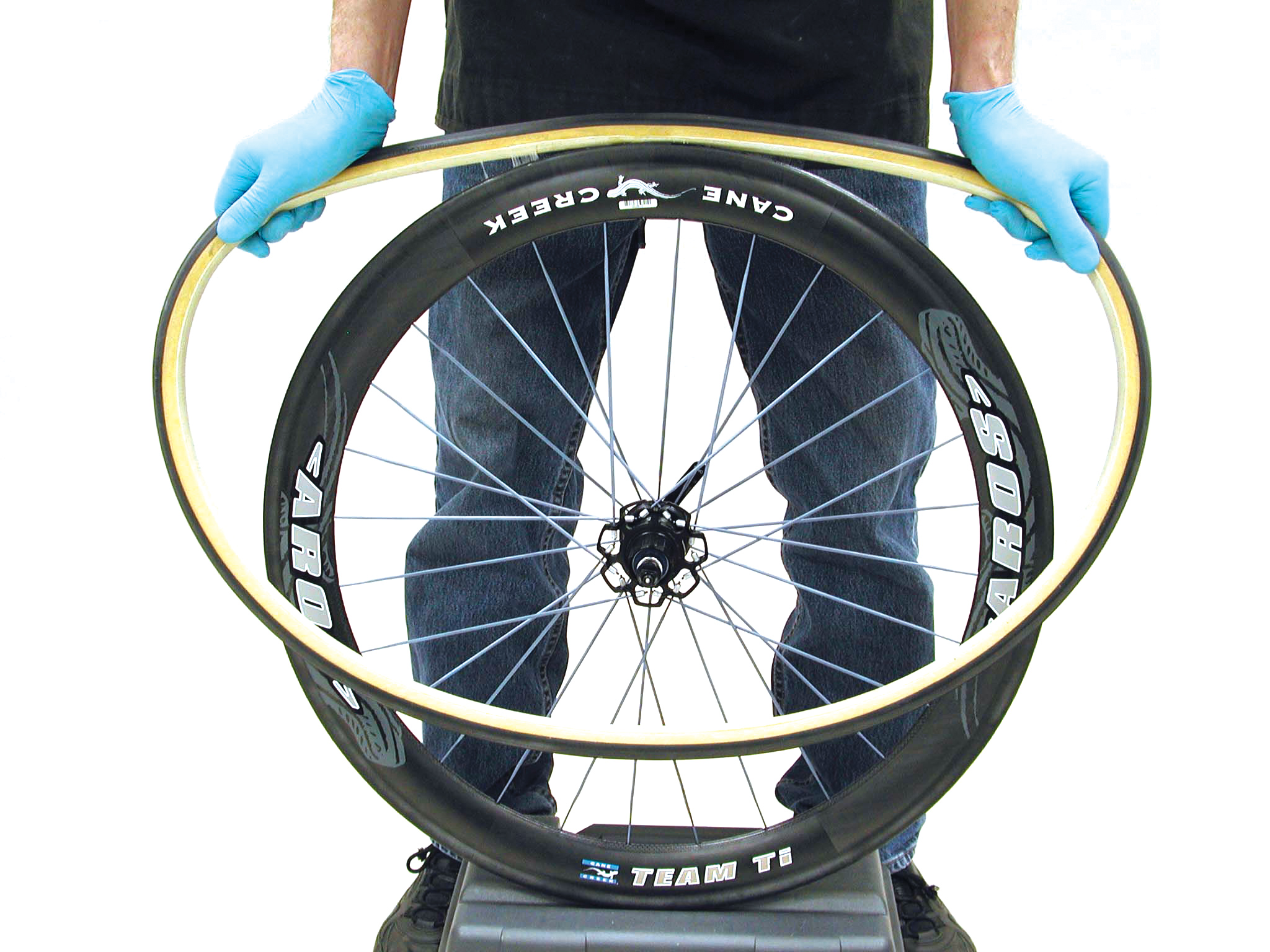
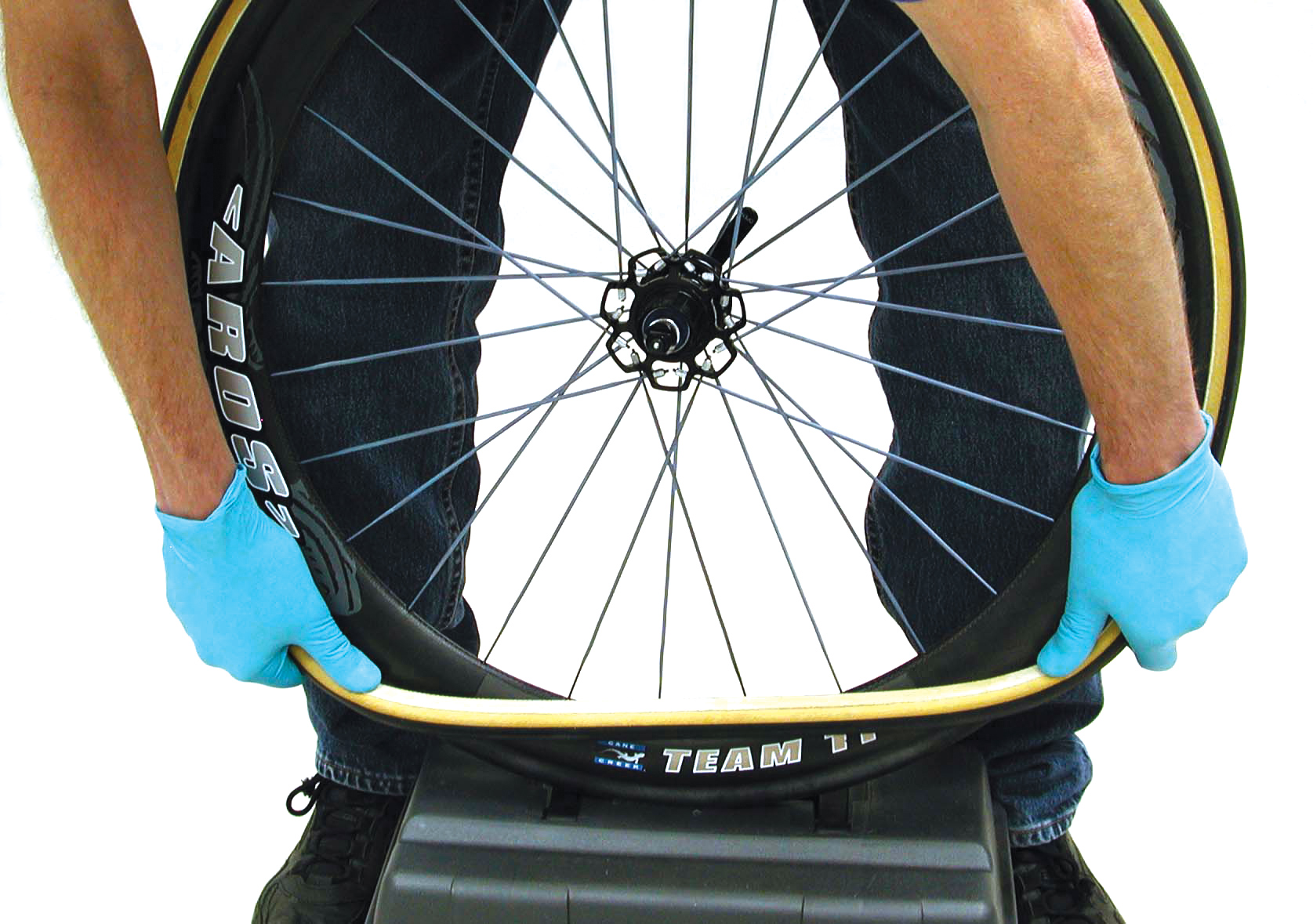
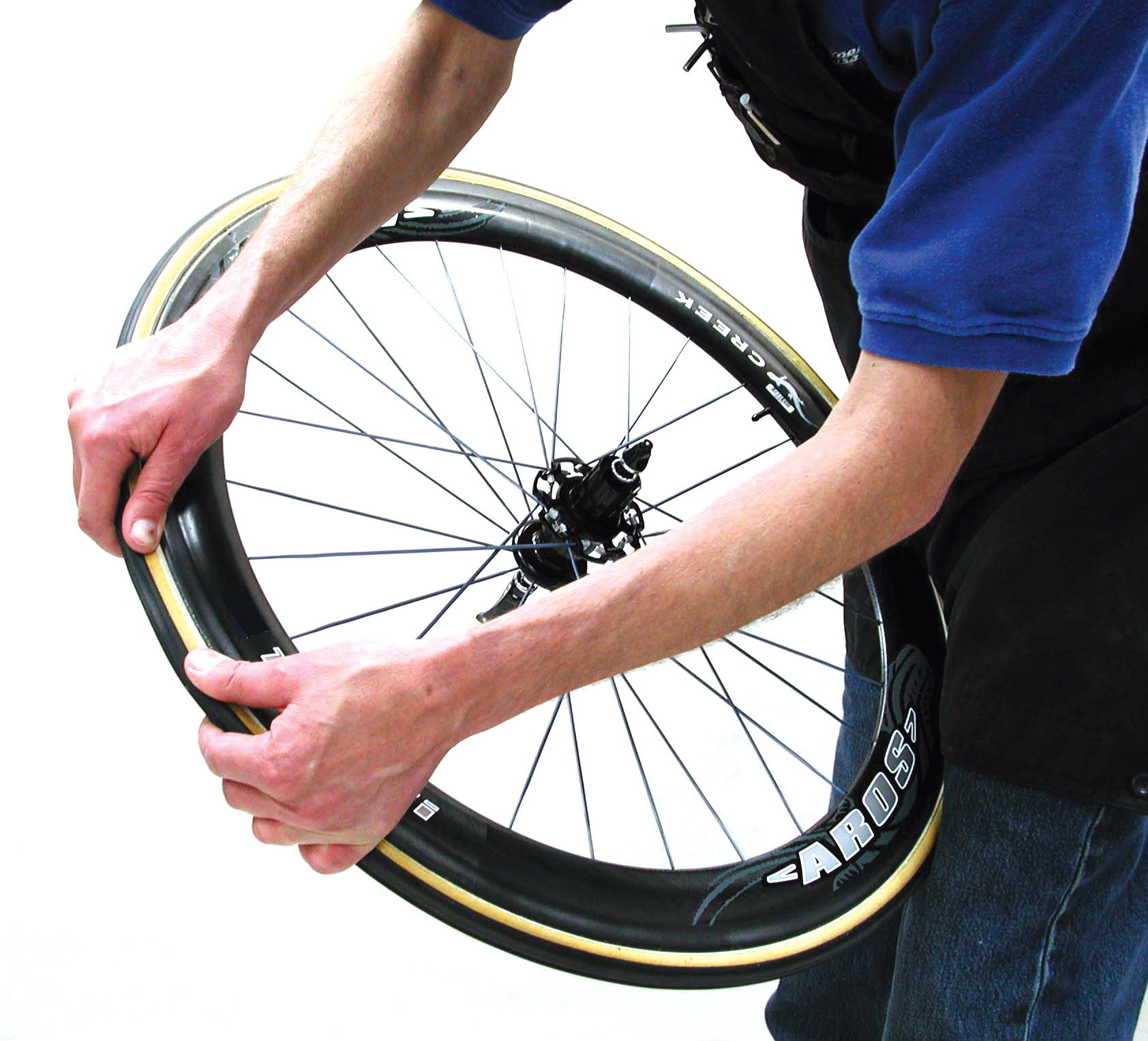
After the tubular is mounted, IMMEDIATELY brainstorm to true and align the tire on the rim. Sight the base tape on both sides of the rim. Generally, the base of operations tape should appear even and centered. Check that the center of the tire is if fact centered on the rim. Pull and twist the tire every bit necessary. It tin can help to deflate the tire further to align, just re-inflate to check final alignment.
Check proper adhesion at this time. Roll the tire back in several places and inspect the glue at the rim and tire interface. Mucilage should be apparent at this area, as seen in the ii images below.
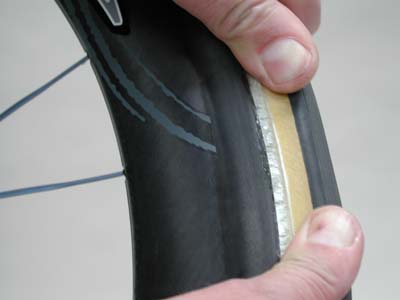
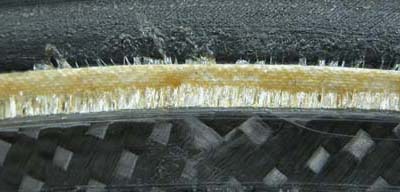
A lack of glue will over again show upward at the border of the tire and rim. The prototype below shows evidence of an inadequate amount of glue, referred to as a "starved joint". Remove this tire and utilize more glue to the rim.
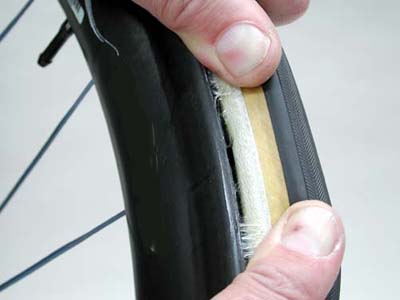
Afterward the tire is aligned, inflate tire fully. Loftier tire force per unit area will assistance printing the base of operations tape fully in the radius of the rim. Information technology can also help to roll the tire along the floor while applying down pressure.
Clean braking surface of any gum. Use a potent solvent and a rag is the rim is aluminum. For carbon rims, wipe off glue as best possible without solvent.
Lastly, the tire MUST be immune to fully cure. This will require fourth dimension for the glue solvent to bleed out. It is recommended that a tire exist allowed to cure for 24-hours. Gluing and using a tire in a short corporeality of time will not allow proper bonding, and tin can pb to failure, no affair the brand of glue.
three
Gluing Process—Used Rim
The gluing procedures will vary depending upon of the condition of the used rim. If the rim already has a base of operations coat, it typically can exist reused. The one-time tire must first exist removed. This may in some cases harm the tire and make it unusable. Deflate the tire completely. Pull back at the tire to work information technology loose in one spot, and and so insert a deadening edged direct tool, such as a steel tire lever or dull tipped screwdriver. Work the tool betwixt the tire and rim. Lever the tool back and along, then slide the tool along the rim to remove the tire.
The old tire, one time removed, will requite indications of the previous gluing. In the image below, the base tape shows very minimal contact.
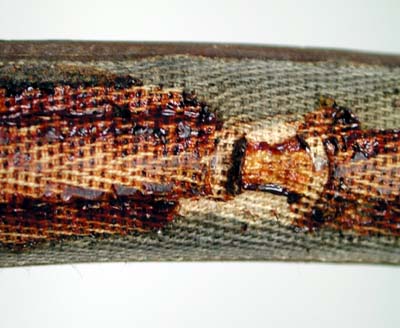
There will often be a layer of clay on the edges of used rims. Utilize a scraper and remove this gum and dirt. Remember, it is the edges that do nearly of the holding. It may be necessary to build upward the previous coat. It is also possible that the quondam coat is thick in some area and bare in other. Utilise glue accordingly. If the base coat is very former, or if it is dirty and contaminated, it should be stripped off. Information technology is possible to use heavy bodied pigment removers. Utilize a biodegradable remover when possible, and follow stripper directions.
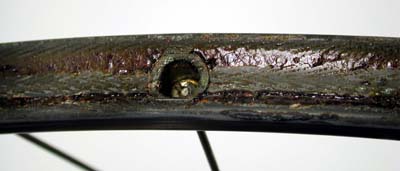
Note: Practise not use paint stripper on carbon rims. Many manufacturers recommend acetone to cut old glue. Contact manufacturer for their recommendations.
The base tape of a tubular is adhered to the tire with glue. If the base of operations tape comes loose from the tire, it is difficult to repair to a "like new" status. Use a thin coat of glue on the base of operations tape. Install tire to a dry out rim and inflate fully to push button tape to rim.
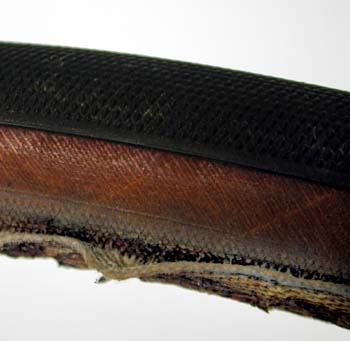
Source: https://www.parktool.com/blog/repair-help/tubular-tire-gluing-sew-up
Posted by: leverettfainizind.blogspot.com



0 Response to "How To Change A Taped Tubular Tire"
Post a Comment